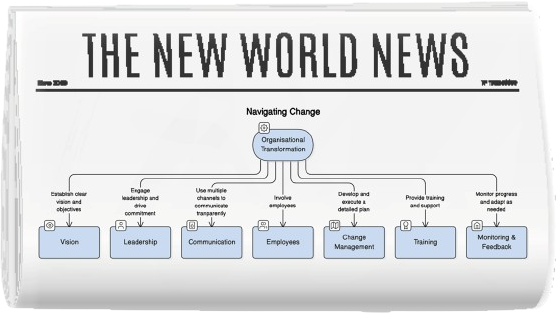
navigating change: effective strategies for organisational transformation
- September 2024
- 8 mins
Organisational change is a strategic imperative. Whether driven by technology, market shifts, or internal restructuring, effective management of transformation is crucial for competitiveness and operational efficiency. This article explores best practices for managing organisational changes with minimal disruption while incorporating modern insights and trends.
UNDERSTANDING ORGANISATIONAL TRANSFORMATION
Organisational transformation involves comprehensive shifts in how a company operates, often requiring changes to structure, processes, culture, or business models. Unlike incremental changes, which are small and gradual, organisational transformations are typically large-scale and require a coordinated effort across the entire organisation.
The need for transformation can arise from various factors, such as mergers and acquisitions, digitalisation, changes in consumer behaviour, or regulatory changes. Regardless of the trigger, the goal is to adapt to new circumstances in a way that enhances the organisation’s ability to achieve its strategic objectives.
BEST PRACTICES FOR MANAGING ORGANISATIONAL TRANSFORMATION
1.Establish a Clear Vision and Objectives
The foundation of any successful transformation is a clear and compelling vision. This vision should articulate what the organisation aims to achieve and why the change is necessary. It serves as a guiding star for all stakeholders, ensuring that everyone understands the purpose of the transformation and the desired outcomes. Clear objectives should be set to measure progress and keep the organisation focused on its goals.
2.Engage Leadership and Drive Commitment
3.Communicate Transparently and Frequently
Transparent and frequent communication is essential for managing change. Employees need to be informed about what is happening, why it is happening, and how it will affect them. Clear communication helps reduce uncertainty and resistance, making it easier for employees to accept and adapt to change. Utilising multiple channels such as meetings, emails, and intranet platforms ensures that messages reach all levels of the organisation.
4.Involve Employees in the Process
Involving employees in the transformation process gains their support and minimises resistance. Employees are more likely to embrace change when they feel that their input is valued and that they have a role in shaping the future of the organisation. Creating cross-functional teams, conducting workshops, and soliciting feedback are effective methods for involving employees in the process.
5.Develop and Execute a Detailed Change Management Plan
A detailed change management plan is essential for guiding the transformation. This plan should outline the steps required to achieve the desired changes, identify potential risks and mitigation strategies, and establish a timeline for implementation. It should also include a communication plan, training and development initiatives, and a framework for monitoring progress. According to Kotter’s 8-Step Process for Leading Change, a well-structured plan increases the likelihood of a successful transformation (Kotter, 1996).
6.Provide Training and Support
Organisational transformation often requires employees to develop new skills and adopt new ways of working. Providing adequate training and support is crucial to ensuring that employees are equipped to handle the changes. This may involve offering formal training sessions, on-the-job coaching, or access to online learning resources. Additionally, providing emotional and psychological support, such as counselling or peer support groups, can help employees navigate the stress and uncertainty that often accompany significant change.
7.Monitor Progress and Adapt as Needed
Change is rarely linear. It is important to monitor progress regularly and be prepared to adapt the plan as circumstances evolve. This involves collecting and analysing data on key performance indicators, soliciting feedback from employees, and being open to making adjustments as needed. Continuous improvement is key to ensuring that the transformation remains on track and achieves its intended outcomes.
MODERN INSIGHTS AND TRENDS IN ORGANISATIONAL TRANSFORMATION

Digital Transformation and Technology Integration
In recent years, digital transformation has emerged as a key driver of organisational change. Companies are increasingly adopting new technologies such as artificial intelligence (AI), machine learning, big data analytics, and cloud computing to enhance efficiency and create new business models. According to McKinsey & Company, successful digital transformations are characterised by a clear digital strategy, the right talent, and a culture that embraces continuous learning
Agile Methodologies and Flexibility
Employee Experience and Change Fatigue Management
As the frequency of organisational changes increases, so does the risk of change fatigue among employees. Managing this fatigue requires a focus on employee experience, ensuring that staff feel supported and engaged throughout the transformation process. Modern approaches to change management include pacing initiatives, providing mental health support, and promoting a resilient organisational culture (CIPD, 2021).
MINIMISING DISRUPTION DURING TRANSFORMATION
- Staggering Changes – Implementing changes in phases rather than all at once allows the organisation to adjust gradually and reduces the risk of overwhelming employees.
- Maintaining a Focus on Core Operations – Ensuring that core operations continue smoothly during the transformation is essential to maintaining customer satisfaction and business continuity.
- Providing Stability Where Possible – While some aspects of the organisation may be changing, maintaining stability in other areas such as employee benefits or company culture can provide a sense of continuity and reassurance.
IN SUMMARY
Navigating organisational transformation is complex but essential for thriving in a fast-changing environment. A clear vision, engaged leadership, transparent communication, employee involvement, and meticulous execution enable organisations to manage transformation effectively with minimal disruption. The incorporation of modern strategies such as digital transformation, agile methodologies, and a focus on employee experience further enhances the likelihood of success. As the landscape continues to evolve, staying adaptable and resilient will be key to sustaining long-term organisational growth.
To further support your transformation journey, Aifa Consulting offers Organisational Development and Resilience (ODR) services. Our tailored solutions help your organisation build the resilience needed to thrive in an ever-changing landscape, Helping you move beyond reacting to change towards strategically leading it.
FURTHER : READING
- Kotter, J. P. (1996). Leading Change. Harvard Business Review Press.
- McKinsey & Company. (2024). What is Digital Transformation?
- CIPD. (2023). Change Management: A Guide for People Professionals. Chartered Institute of Personnel and Development. Retrieved from CIPD.
- Cameron, E., & Green, M. (2024). Making Sense of Change Management: A Complete Guide to the Models, Tools and Techniques of Organisational Change. Kogan Page.
- MIT Sloan School of Management. (2022). Leading the Future of Work. How to empower your workforce to master new technologies and navigate evolving risks.

